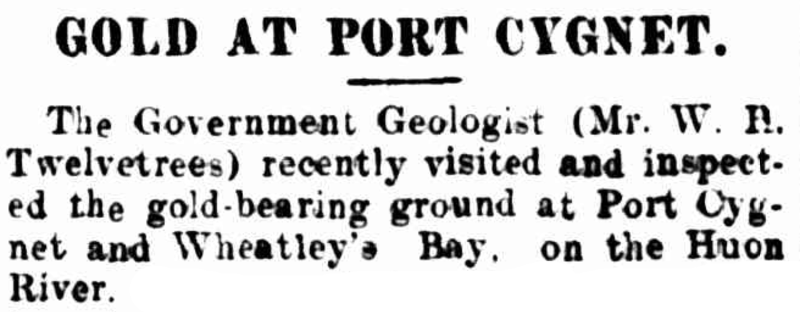Most Tasmanian gold is found in either the northeast or the western part of the State. Gold in southern Tasmania is more elusive and harder to find than in the north-east and west of the State. The Cygnet goldfield was the main occurrence, but there were minor finds in other locations as well, such as elsewhere in the Huon Valley and Adamsfield. I’ll leave Adamsfield for another post, and concentrate on the Huon Valley gold occurrences in this one.
Cygnet gold
The main goldfield in southern Tasmania is centered around Cygnet. The first discovery occurred in 1854, which is remarkably shortly after the first discovery in Mangana.
A newspaper report in “The Courier” annouces the discovery of gold at Three Hut Point (modern-day Gordon, in the d’Entrecasteaux Channel) on the 1st of December 1854. Some nuggets were brought into Hobart that had reputedly been found at Three Hut Point, and a bit of a rush occurred. By the 6th of December, 35 people are reported to have been digging around for gold in the area. Doubts seem to have quickly crept in, with papers like the Colonial Times referring to the ‘alleged gold find’. By the 23rd of December, newspapers like The Hobarton Mercury report the find as a fake, but also report (in skeptical tones) the discovery of gold in Port Cygnet.
Hoax?
The Three Hut Point find may well have been a hoax, but it seems like a very good coincidence that it happened to be located in an area near to two well-known gold occurrences: the Cygnet gold field, and the Little Oyster Cove gold field.
As an interesting aside, the Colonial Times edition of the 6th of December 1854, linked to above, also reports the simultaneous goings-on at the Eureka Stockade, in Ballarat.
Cygnet gold occurrences
The main gold occurrences of the Cygnet goldfield are the alluvial of Forsters Rivulet and Golden Valley Creek, and eluvial and alluvial smaller occurrences from Petcheys Bay, Kubes Hill, Kubes Rivulet, Silver Hill and Tobys Hill.
Access today
Pretty much all the gold occurrences in the Cygnet district are located inside private property, mostly farmland. Part of the banks of Forsters Rivulet is an informal reserve, and it’s shown as available for mining by MRTmap. Other than that, and along the foreshore, organising permission to access is a must. You can use MRTmap and LISTmap to research tenements and land tenure in the area. I have heard of people panning fine gold in Wheatleys Bay and Petcheys Bay, and I’ve heard of a couple of small nuggets having recently been panned and detected from the Cygnet area, so if you can get permissions, I think it’s well-worth spending some time there, and it’s a lot closer than the next-nearest goldfield.
Other Huon Valley gold occurrences
Gold has been reported very vaguely from some of the rivers draining the Southern Ranges. The source of the gold was never found, but colours have been found in the Esperance, Lune and d’Entrecasteaux rivers. Rumours have been rife for a long time, but a lot of the area is now inside the expanded National Park and World Heritage Area, and out of bounds to prospecting, but the mouths of the rivers are still mostly fair game.
The other main gold occurrence in southern Tasmania is in the area around the headwaters of the Weld River, around and north of Glovers Bluff, and the wilderness area to the west. Some of the recorded occurrences or minor workings were in the immediate area of Glovers Bluff, as well as Snake Creek and Manuka Creek to the west. The source of the gold isn’t clear, but might be related to the ultramafic (serpentinite) outcrops that occur as a south-eastwards extension of the Adamsfield body. Minor outcrops associated with gold and osmiridium are known from the upper Florentine, Huon River headwaters, the Fourteen-Mile Creek area near Maydena, the Styx River, the very headwaters of the Weld, and Glovers Bluff. Another minor occurrence is known from near Osmiridium Beach, on the South Coast.
Useful references
- R.S.Bottrill (1995). A summary of mineral exploration in the Cygnet–Kettering area.
- R.S.Bottrill & J.Taheri (1999). Porphyry and sedimentary-hosted gold deposits near Cygnet.
- R.S.Bottrill et al. (1999). The nature and origin of gold mineralisation at the Forster Prospect, Glovers Bluff/Weld River area.
- J. Harcourt Smith (1898). Report on the discovery of gold at Port Cygnet.
- W.H.Twelvetrees (1902). Report on gold and coal at Port Cygnet.
Do you have a topic you’d like me to write about, or want to leave some feedback? If you like the content at Apple Isle Prospector, feel free to get in contact, or leave a comment. If you enjoyed this article, then let others know by sharing it on Facebook or liking our Facebook or Twitter pages:




Interesting stuff. I lived on Silver Hill for a few years.
The area down south around the Weld River looks promising.
Thanks for your informative blog and we hope you have a great new year.
Thanks John,
The main problem in the Cygnet area is lining up permissions to access the (mostly) private property. The Weld area is interesting, but I don’t know of any decent finds in recent times. A lot of prospective country in that area has been gobbled up by the World Heritage Area and is now out of bounds. It pays to check the current boundaries on LISTmap.
Hi I wanted to have a chat about gold in southern Tasmania. I have found quite a bit but am unsure about a few regulations like slucing ect…
It’s very dependent on where you are. Prospecting licences (you need one unless you’re willing to risk the $15,000 fine) tell you that sluices are a no. However all this talk of ‘motorised’ stuff in the licence makes me think they’re confusing sluices with dredges. I’ve been personally told by various people that a small river sluice is ok. The spirit that seems to be followed is that if it’s small enough to carry around with you in the bush all day, it’s ok for prospecting.